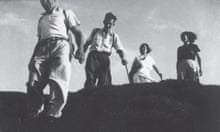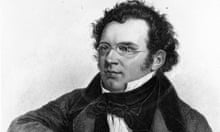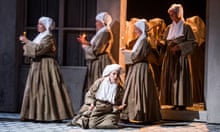Annilese Miskimmon is director of Puccini’s Madama Butterfly for Glyndebourne Tour, the company’s first ever staging, opening on 14 October and touring to Milton Keynes, Canterbury, Norwich, Woking and Plymouth until 10 December. Born in Belfast in 1974, Miskimmon has been general manager and artistic director of Danish National Opera since 2012, and leaves to take up the same position next year at Norwegian National Opera.
The Guardian’s product and service reviews are independent and are in no way influenced by any advertiser or commercial initiative. We will earn a commission from the retailer if you buy something through an affiliate link. Learn more.
Why is Madama Butterfly so enduringly popular?
I see this opera as a beautiful red apple with a poisonous worm at the heart. That tension, that eternal clash between beauty and brutal truth, is what elevates it to a great masterpiece. It’s not just a sentimental story about a young Japanese girl and a handsome American naval officer. There’s something compelling and dark at its core. It’s easy to underestimate the extraordinarily ambiguous power of the music. And it addresses so many issues still vital to us today: racism, imperialism and especially the grooming and sexual abuse of a 15-year-old girl.
I never, ever considered opera an alien form. It’s just a really dramatic story with big music after all
Are those issues, especially the grooming and abuse, important only from our modern perspective? Were they Puccini’s concerns too?
It’s very clear from the way he adapted the original David Belasco play that Puccini knew he was dealing with a deeply flawed character in Pinkerton, whose obsession with Butterfly’s youth is clear from the start. He comments on how young his Japanese bride is, how theirs is not a real wedding, and how one day he will be “properly” married to an American woman. The sordid beauty, as well as the avant-garde aspects of the original play – such as its 14-minute silent scene when nothing happened on stage apart from Butterfly waiting for Pinkerton – are immortalised in the opera’s DNA. Puccini turns that wordless scene into the famous Humming Chorus interlude, to stunning dramatic effect.
Should we see direct connections with Puccini’s own life – particularly a relationship with a young maid which had a tragic outcome?
I don’t think he could have created women of the complexity he does – Tosca, Manon Lescaut, Mimi (the true artist of La bohème as far as I am concerned) – without some aspects relating to his own experiences. Here it’s as if he understands the determination, the urge of Pinkerton to possess someone as young and beautiful as Butterfly. This work leaves you, whether as director or audience, feeling both ravished and corrupted. At the end there’s no resolution. It’s not cathartic. You can’t walk away from it – it remains with you, in the head, in the heart, in the psyche.
You grew up in Northern Ireland in the 70s and 80s. What was the impact on you? Was there much chance to discover opera?
Only in retrospect can you see how your childhood shaped you. So yes, growing up in Belfast – actually just outside, in Bangor – left a profound mark. From an early age opera helped me escape the Troubles, as well as being central to my own imagination. There wasn’t much of a professional opera scene, but the amateur side was lively. The first show I saw, as a 10-year-old, was an amateur production of Mozart’s The Magic Flute – with my father singing Papageno – in a church hall in Belfast. Opera and theatre were, and still are, a safe place for open-minded, creative people from both communities, a defence against all the sectarian problems. Art united while religion and politics divided.
Although Handel’s music may seem incredibly remote from Puccini’s, it’s a relatively easy psychological leap
First Danish Opera, now you’re off to Norway…
The Scandinavian countries are fascinating artistically. Norway especially has such an open-minded attitude to what opera is. I feel my job there is to explore what a 21st-century company can be, and to do so in the fabulous opera house that was designed as a democratic space for all is very inspiring.
You’ve said you were influenced by Star Wars and Mary Poppins – a good start for opera?
Yes, but I never, ever considered opera an alien form. I was hooked from the start. It’s just a really dramatic story with big music after all. The same principle as a concept album really. I always admired the Muppets’ ability to put on a show despite all odds. And Deacon Blue, Ella Fitzgerald, Stephen Sondheim, Radio 4 drama, Shakespeare, Hitchcock and Gerard Manley Hopkins – that particular uncool artistic cocktail got me through my teenage years and beyond, but my greatest regret is that I grew up pre-Beyoncé.
What’s next in the UK?
Semele at Garsington next year. It’s a fabulous piece – once again about a woman who is prized sexually but whose humanity is a bit of an inconvenience to her romantic partner. So although Handel’s music may seem incredibly remote from Puccini’s, it’s a relatively easy psychological leap from one to the other.
Will you reveal something about your Madama Butterfly production?
A little hint is that it’s not only about the horror of buying and selling one beautiful butterfly, but of many such transactions. But it’s funny and beautiful and romantic as well – a reminder that, just like real life, tragedy is always part of a bigger, complex human story.
- Madama Butterfly is in rep at Glyndebourne, east Sussex (14 Oct-3 Nov); Milton Keynes theatre (9,12 Nov); Marlowe theatre, Canterbury (16,19 Nov); Theatre Royal, Norwich (23,26 Nov); New Victoria theatre, Woking (30 Nov, 3 Dec); and Theatre Royal, Plymouth (7,10 Dec)






Comments (…)
Sign in or create your Guardian account to join the discussion